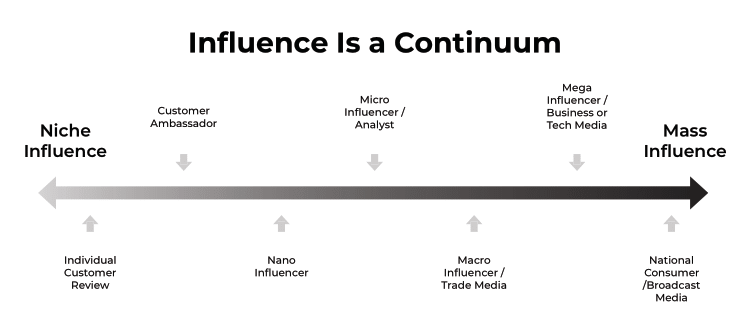The Long Tail of Spoken Truths
The term “speak your truth” may not be an Oxford Dictionaries’ Word of the Year like “post-truth,”...

(Following is Chapter 2 of Trust Signals: Brand Building in a Post-Truth World.)
In 2016, Oxford Dictionaries named “post-truth” its Word of the Year. A Google search for the term today yields more than 2.5 million results.
The word was coined by writer Steve Tesich after the US government prohibited the news media from covering the 1991 Persian Gulf War except in carefully controlled press pools. In a piece in The Nation, Tesich lamented that the public had been fed only social, sanitized accounts of the conflict—and had barely protested (Kreitner 2016).
This was in sharp contrast to the Vietnam War, when American journalists roamed freely in Saigon and the Vietnamese countryside, recording and amplifying the trauma of that conflict.
Tesich’s conclusion was this:
We came to equate truth with bad news and we didn’t want bad news anymore, no matter how true...In a very fundamental way we, as a free people, have freely decided that we want to live in some post-truth world. (Kreitner 2016)
Tesich’s analysis describes the fundamental challenge our public institutions and businesses face today. Because thanks to social media algorithms and competing media echo chambers, Americans never have to encounter bad news anymore—or at least not news that conflicts with their chosen point of view.
Oxford Dictionaries defines post-truth as “circumstances in which objective facts are less influential in shaping public opinion than appeals to emotion and personal belief” (Oxford Languages, n.d.). Ironically, however, in a post-truth world, even this definition is subject to debate because many people don’t believe objective facts are “less influential.” They believe they simply don’t exist.
This reality is both a result of and reason for the decline of mainstream media gatekeepers, which I described in the opening chapters of this book. Audiences have fragmented and scattered across thousands of information sources that align with their interests and cater to what Edward Bernays called their preferred “prejudices and symbols and cliches and verbal formulas.”
Use of the term “post-truth” by the media and public began climbing the charts on June 16, 2015—the day Donald Trump descended that golden escalator to announce his bid for the presidency.
Few topics are more divisive today than Trump. But while much of the reporting on Trump has focused on his controversial positions and brash rhetoric, I would argue that this is not what has created the huge chasm between Trump’s supporters and his detractors.
The main issue was, and is, truth—specifically, different understandings of what’s true and what’s not.
The Washington Post claimed Trump made more than 30,000 false or misleading statements during his four years in office (Kessler, Rizzo, and Kelly 2021). A 2020 Pew Research Poll found that only 7 percent of Democrats considered Trump “honest.” And yet, that same poll revealed that more than 70 percent of Republicans judged him to be truthful (“Public’s Mood Turns Grim”).
In fact, millions of Trump’s fans believe that he is the most trustworthy leader we’ve ever had—or as political analyst Bruce Wolpe (2019) put it, “the most ruthlessly honest president of modern times.”
![]()

In July 2020, I wrote a post on the question-and-answer website Quora responding to the question, “Why do you support Donald Trump?” The answer earned hundreds of thousands of views and thousands of upvotes, with plaudits equally divided between liberals and conservatives. Here’s that Quora answer.
I don’t personally support Donald Trump, but I know many who do. Here’s my take.
The other day, I was searching a thesaurus website for synonyms of “strategy.” I was stunned by the words the site listed as its antonyms: “honesty” and “openness.”
Hmm. What’s that about?
The Oxford definition of “strategy” is simply “a plan of action or policy designed to achieve a major or overall aim.”
Why does this suggest dishonesty or lack of openness?
I think it relates to the human instinct to associate spontaneity with candor, and deliberate planning with manipulative plotting.
I had a girlfriend once who broke up with me during an argument. One reason she gave for her decision was that I took too long to answer her questions.
“What?” I asked her.
She thought that when she asked me about our relationship, religion, or any other topic big or small, I should be at the ready with a response.
Unfortunately, that’s not me. I like to be thoughtful when asked a question—so I tend to pause and prepare for a moment before saying anything.
In my ex-girlfriend’s mind, I was plotting. I was coming up with the answer I wanted her to hear, rather than simply telling her the truth that should have been on the tip of my tongue.
“What does your crazy ex-girlfriend have to do with a discussion about strategy?” you might be asking.
Well, she actually wasn’t so crazy. Many people think a person is more honest when they are less careful in their choice of words.
Even President Donald Trump’s biggest supporters would be unlikely to label him a meticulous strategist. He exudes spontaneity in every sound bite, public appearance, and tweet.
And that’s why millions of Americans believe he’s the most honest US president—perhaps even politician, period—our country has ever seen, despite significant objective evidence to the contrary.
Americans who voted for Trump in 2016 were looking for the exact opposite of a classic politician.
An antonym, if you will.
After all, politicians have never been known for their spontaneity. They have been known for being calculating, judicious, crafty, cautious—strategic.
Historically, they have been trained to be all things to all people, while having views that perfectly coincide with their party’s platform. Their carefully crafted sound bites—however acrobatic—have become increasingly alienating to voters.
When people see Trump, they see someone who is being himself, for good or ill.
He’s himself, and despite enormous pressures—from his party, from the media, from everyone—he has refused to change. He has refused to apologize. He has doubled down on being true to himself.
That’s why so many people trust him. To his supporters, the many small lies Trump is caught telling are nothing compared to his rare, unscripted consistency as a person.
His supporters don’t love him despite his lack of careful strategy and deliberate communication. They love him because of it.
![]()
The divide over Trump and truth gets to the essence of what “post-truth” means in practical terms today—for the media, the public, and brands.
If the same person can be both the “most honest” and “most dishonest” president in history, depending on the audience, what does this say about the importance of understanding which audiences your brand is targeting and how best to engage with them?
While post-truth is usually discussed in a political context, its implications for business are far-reaching and transformative. Every brand must have trust to succeed, and earning that trust requires third-party validation from media outlets and other sources of influence that buyers consider credible and authoritative.
That goal becomes harder to achieve in a post-truth world, when the sources of third-party validation themselves are not only more fragmented, but also less trusted.
The disappearance of shared sources of truth, such as media gatekeepers and civic institutions, means that a brand must carefully sift through a highly fragmented information landscape to cobble together a collection of sources that will have credibility for the brand’s target audience.
The term “speak your truth” may not be an Oxford Dictionaries Word of the Year like “post-truth,” but it has gained similar popularity in recent years.
Particularly for those who believe their voices haven’t always been heard in mainstream culture, it’s powerful phrasing. Unlike simply sharing an opinion or experience, stating your “truth” implies that others’ understanding of the truth may be flawed or incomplete.
It also conveys an inarguable quality. Your opinion can be changed. Your experience can be enriched. Your “truth,” however, is immutable.
We live in a world that is not only post-truth, but in which people speak their truths in places where they know they will find friendly audiences—social spheres where open disagreement can quickly lead to excommunication.
What does this have to do with brands? A lot.
Back in 2004, Chris Anderson of Wired magazine popularized the statistical term “long tail” for online marketers, explaining that in an era of unlimited web “shelf space,” products that have a low sales volume could collectively earn a market share exceeding that of the comparatively few high-volume products, if the distribution channel were large enough (“The Long Tail”).
At a time when Amazon was on course to overtake Walmart as the most powerful retailer in the world, it was hard to argue Anderson’s point. Since that time, the long tail has emerged as a key consideration for marketing strategists in an environment of ever-increasing media fragmentation and niche marketing.
But this era of unlimited digital shelf space is relevant not only to product marketing; it applies to public discourse as well. Our “spoken truths” have a long tail, too.
That’s why lesser-known social media influencers who barely earn a peep of attention on mainstream media, for example, can collectively drive greater results for a brand than the mainstream outlets that ignore them. These influencers have smaller followings, but impassioned ones that trust them because of their shared truths.
I recently spoke with a PR practitioner who told me that in working to drum up attendance for a local event, she had great difficulty securing stories in the local newspaper and business weekly. After much time and effort, she was finally able to score the placements— but after all was said and done, the event could track zero registrations to that coverage.
On the other hand, landing a mention in the email newsletter of a highly opinionated local influencer was a key driver of registrations and helped make the event a success. The reason is that, while small, the influencer’s audience was more targeted and far more passionate about the event’s subject matter. The influencer’s audience also trusted that if he endorsed the event, it was worth their time and money.
And here’s the kicker: my friend actually paid the influencer for the mention. It was not an “earned” placement; it was sponsored. But because the influencer’s audience trusted his recommendations, whether he was paid to make them or not was irrelevant.
Brands must recognize that in a world without gatekeepers influence is a continuum.
It begins, on the low end, with any customer who leaves a review of your company or product on an online-review site. While this individual reviewer might not have a recognized name, their review nevertheless has an influence on those who read it.
If that customer already has an established following on social media, their influence when saying something positive (or negative) about your business is that much greater. The greater the influencer’s following, the larger their megaphone.
As influencers increase their name recognition and audience size, they progress on the continuum from nano-influencer all the way up to mega-influencer.

You can think of mega-influencers as major media outlets, like The New York Times, and big celebrities, like the Kardashians.
The New York Times and the Kardashians are obviously very different sources of information, but both are highly trusted by certain segments of consumers. Your job as a marketer or PR professional is to identify the continuum of influence—from the individual customer to major media outlets—that are the most valuable sources of truth for your audience.
I should add that (while this point may make PR traditionalists blanch) it doesn’t matter whether the influencer is paid or organic as long as they are transparent about brand sponsorships. Focus on whether an influencer has a real following and real credibility with that following—then, determine how well that following matches your audience.
The range of options in a brand’s continuum of influence should make evident the importance of primary research into the habits and beliefs of your buyers and other key audiences.
The playing field is far more complex and the stakes much higher than in the past. It’s no longer sufficient to gather a group of executives in a conference room, whiteboard their opinions, and call it a day. You should perform quantitative and qualitative research that includes buyer personas as well as trust profiles that study your audience’s sources of influence in detail. (We’ll discuss trust profiles later in this book.)
During this research, your objective is to discover what sources inspire trust, as well as distrust, in your buyers and other audiences. The answers may surprise you—and it’s not something that should be left to guesswork or chance.
Years ago, I began seeing the implications of a post-truth world on business. I had just scored a major New York Times feature opportunity for one of my agency’s oil-and-gas clients.
In the past, this would have been a huge coup for our agency and our client. This time, the client’s CEO—after originally accepting the interview—turned it down at the last minute because “nobody trusts the Times anymore.”
Of course, it wasn’t true that nobody trusted The New York Times. But it was true that it had lost credibility with many in the energy industry, including this client’s own customers. The company’s CEO had actually been talked out of the interview after conversations with his own employees and customers.
For them, The Wall Street Journal, Fox Business Network, or even the local newspaper had become a more trusted source of influence.
I hadn’t done my research before securing this placement, and it cost me. That New York Times reporter never wanted to hear from me again.
Remember the controversy in 2018 when Nike made civil-rights activist and former NFL star Colin Kaepernick one of the faces of its thirtieth anniversary “Just Do It” campaign? Almost immediately, a #BoycottNike hashtag began trending on Twitter, and conservative media personalities lambasted the brand for choosing Kaepernick as a spokesperson.
And yet, Nike’s sales and stock skyrocketed.
This result did not come as a surprise to Nike. Based on audience data, the company knew the association with Kaepernick would build trust and resonate with its core customer base, especially millennial and Generation Z men.
For another brand, an association with the same athlete might have been disastrous. For Nike, it was pure gold—because Kaepernick was a perfect fit in the brand’s continuum of influence.

Scott is founder and CEO of Idea Grove, one of the most forward-looking public relations agencies in the United States. Idea Grove focuses on helping technology companies reach media and buyers, with clients ranging from venture-backed startups to Fortune 100 companies.

The term “speak your truth” may not be an Oxford Dictionaries’ Word of the Year like “post-truth,”...

With 69% of consumers stating they trust influencer recommendations, the right partnership could...
Leave a Comment